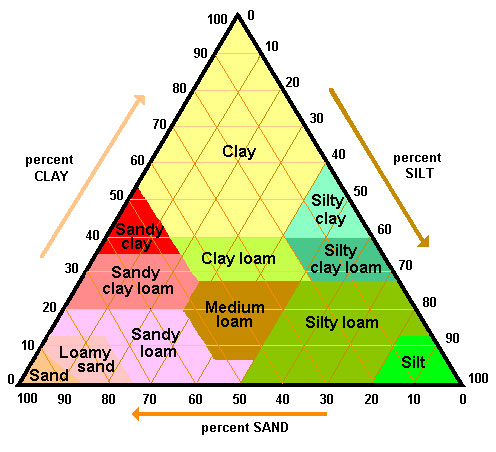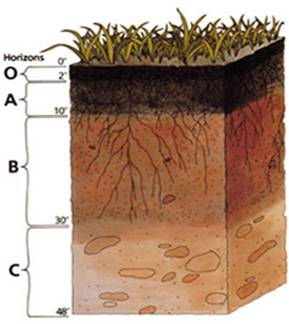
Soil Science
- Home
- EPA Presentations
- Principles for Ecological Land Reuse
- Soil Science
- Soil Amendments
- Terrestrial Carbon Sequestration
- Plants and Revegetation
- Growing Gardens in Urban Soils
- Ecosystem Services
- Creating Pollinator Habitats as Part of an Ecological Revitalization Project
- Act Locally
- Land Revitalization Assistance
- Case Study Profiles
- Publications, Resources, and Links
- Glossary of Ecological Land Reuse Terms

Soil pH
Soil pH, a measure of soil acidity (pH <7) or alkalinity (pH >7), affects the availability of nutrients to plants. Certain nutrients are less available to plants in soils where the pH is too low or too high. When a soil's pH is near neutral, (pH 7) nutrients are more readily available to plants, and microbial populations in the soil increase. If necessary, a soil's pH can be changed by adding soil amendments. Soil amendments such as lime or wood ash raise the soil pH.
For detailed information, please visit the Natural Resources Conservation Service Soil Quality Information Fact Sheet on Soil pH. EPA's Acid Rain website also has a useful description of pH.
Soil Nutrients
Nutrients are elements that nourish and enrich the soil, making it more suitable for plant growth. Fifteen of the 17 nutrients that are essential for plant growth are obtained from the soil. Therefore, sound soil nutrient management is essential to ecological revitalization projects.
The three primary nutrients needed to sustain healthy plant life are nitrogen, phosphorus, and potassium. These elements have crucial roles in promoting plant growth and development, regulating water uptake, and converting sunlight into chemical energy through photosynthesis. Other essential nutrients such as calcium, sulfur, and magnesium regulate nutrient transport and are important structural components. Although these may be found naturally in some soils as a result of processes such as mineral weathering (breakdown) or decomposition of organic matter, many ecological reuse projects rely on artificial modification of the soil through the addition of fertilizer and other soil amendments. Amendments are materials added to soils in order to make them suitable for sustaining plant life or development. For more information on soil amendments, please visit the EcoTools Soil Amendments Page.
Soil nutrient management is a complex process that depends on several factors, including geography, climate, the physical properties of the soil, and the type of plant life on the site. For additional information and best practices on nutrient management, please visit the EPA's National Agriculture Center Web Site on Nutrient Management. For additional information on nutrients needed to sustain healthy soils and crops, please also visit the University of Minnesota Extension Service Guide on Nutrient Cycling and Maintaining Soil Fertility .
Soil Texture
The texture, or "feel" of the soil is a very important characteristic. Soil texture affects how water and nutrients are retained, the type of plant life it can sustain, and susceptibility to erosion.
Texture is defined by the relative proportion of the three primary soil particles present in the soil: sand, silt, and clay. Since each particle size has quite different physical characteristics, the nature of a soil is commonly defined by the most abundant particles. Thus, a soil possessing a large amount of clay has quite different physical properties from one that consists mostly of sand and/or silt. Soils that are made up of relatively equal amounts of each size type are known as "loams." Soil textural triangles such as the one on the right are used to determine the texture classification. The number scale on the outside of the triangle represents the percentage of sand, silt, and clay, and the intersection of each line gives the texture classification. For example, a soil that has 30 percent clay, 40 percent silt, and 20 percent sand falls into the "silt loam" texture class.
For a detailed guide that includes step-by-step instructions on determining soil texture, please visit the United States Department of Agriculture's (USDA) Guide to Texture and Feel.
Soil Horizons
Soil scientists classify soil into different layers, or horizons. Each horizon has its own physical and chemical characteristics. Horizons are formed by a range of chemical, geological, and biological regions, and vary by geographic location.
The USDA classifies soil horizons based on depth and composition. The graphic below shows a sample soil classification with the most common horizons:
O Horizon: Usually the surface layer in most soils, the O Horizon is composed of decaying plant matter.
A Horizon: Characterized by dark brown/black color, the A Horizon is at or near the surface and rich in organic matter.
B Horizon: Commonly referred to as subsoil, the B Horizon consists of mineral layers and has very little organic matter, if any. Minerals accumulate in this layer through leaching from the surface soils. Plant roots usually penetrate into this layer. The B Horizon also is commonly divided further into subtypes, depending on depth and mineral content.
C Horizon: The C Horizon consists of unweathered rock and parent material, and is not usually affected by surface actions.
Additional Resources
- Lead in Urban Soils Workshop.
On September 15-16, 2015, EPA Region 3 hosted the Lead in Urban Soils Workshop in Philadelphia, PA. The workshop featured over 20 presentations and discussion on the issue. A summary report, PowerPoint Presentations, and archived recordings of the presentations and discussion are archived on CLU-IN. - NRCS Soils Website. United States Department of Agriculture, Natural Resources Conservation Service.
The U.S. Department of Agriculture's main gateway to soil-related information. Includes links to state-by-state soil surveys and descriptions, soil classification guides, and conferences and other educational opportunities. - Soil Science Society of America
Professional society dedicated to advancing soil science through research, education, and advocacy. - Soil pH: What it Means. State University of New York, College of Environmental Science and Forestry.
A primer on soil pH and its effect on plants, as well as information on how to measure pH levels in soil. - Understanding Lead and Arsenic Bioavailability in Soils at Superfund Sites.
This fact sheet, developed by the University of North Carolina Superfund Research Program, has information on lead and arsenic, their effects on human health, exposure and risk assessment, and what individuals can do to reduce exposure.






